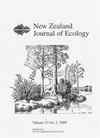The effect of aerially applied 1080 on the nesting success and survival of kākā
IF 1.4
3区 环境科学与生态学
Q3 ECOLOGY
引用次数: 0
Abstract
: Kākā ( Nestor meridionalis ) are vulnerable to predation by stoats ( Mustela erminea ) and possums ( Trichosurus vulpecula ), particularly when nesting. Without predator control kākā populations decline. Control of stoats and possums both by trapping and aerial application of the poison 1080 leads to increased kākā nesting success. In recent years, many 1080 poison operations have been undertaken to control ship rat ( Rattus rattus ) and stoat plagues that occur after beech mast. Kākā do not breed every year but breed in anticipation of heavy fruiting. They do not usually breed during the spring and summers following beech mast when 1080 operations are often undertaken to control rat and stoat irruptions. Using radio-tags we measured the nesting success and survival of kākā for six years in South Westland during which there were beech (Nothofagaceae) and rimu ( Dacrydium cupressinum ) masts, stoat and rodent plagues, five 1080 operations, and four seasons in which kākā bred. We then simulated varying timings and frequencies of masting and 1080 use to explore the impact of masting and predator control on kākā population growth. In the absence of pest control simulated kākā populations declined. Aerial 1080 applied a year before or just before kākā breeding resulted in increased nesting success, but 1080 applied more than two years before kākā breeding had no impact. Aerially applied 1080 also increased adult kākā survivorship for at least 18 months. Annual 1080 operations or 1080 operations at intervals less than or equal to the time it takes stoat populations to recover resulted in the most rapid simulated kākā population growth. 1080 operations in (1) kākā breeding years, (2) when following mast, and (3) during rodent and stoat plagues each resulted in progressively smaller kākā population growth rates.空中施放1080对kākā产卵成功率和成活率的影响
本文章由计算机程序翻译,如有差异,请以英文原文为准。
求助全文
约1分钟内获得全文
求助全文
来源期刊

New Zealand Journal of Ecology
环境科学-生态学
CiteScore
3.00
自引率
12.50%
发文量
35
审稿时长
>36 weeks
期刊介绍:
The New Zealand Journal of Ecology is a biannual peer-reviewed journal publishing ecological research relevant to New Zealand/Aotearoa and the South Pacific. It has been published since 1952 (as a 1952 issue of New Zealand Science Review and as the Proceedings of the New Zealand Ecological Society until 1977). The Journal is published by the New Zealand Ecological Society (Inc.), and is covered by Current Contents/Agriculture, Biology and Environmental Science, GEOBASE, and Geo Abstracts.
 求助内容:
求助内容: 应助结果提醒方式:
应助结果提醒方式:


